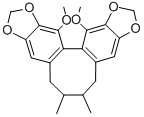Schisandrin C is a lignan originally isolated from Schizandrae that has diverse biological activities. It decreases viability of U937 cells in a concentration-dependent manner and induces cell cycle arrest at the G1 phase when used at a concentration of 100 μM. Schisandrin C (5-20 μM) decreases hydrogen peroxide-induced cell death and production of reactive oxygen species (ROS) in C2C12 skeletal muscle cells. It also decreases levels of matrix metalloproteinase-2 (MMP-2), MMP-9, COX-2, VCAM-1, IL-1β, and TNF-α in hydrogen peroxide-stimulated C2C12 cells. Schisandrin C decreases lipoteichoic acid-induced production of nitric oxide (NO), prostaglandin E2 (PGE2; ), TNF-α, IL-1β, and IL-6 in mouse primary microglia. In vivo, schisandrin C (200 mg/kg) decreases serum alanine amino transferase (ALT) and aspartate amino transferase (AST) activity, increases hepatic mitochondrial and total glutathione (GSH) levels, and reduces liver injury in a mouse model of acetaminophen-induced liver injury partially via inhibition of the cytochrome P450 (CYP) isoforms CYP2E1, CYP1A2, and CYP3A11.

